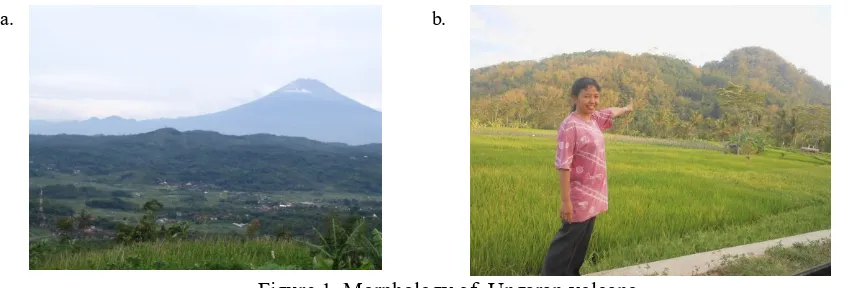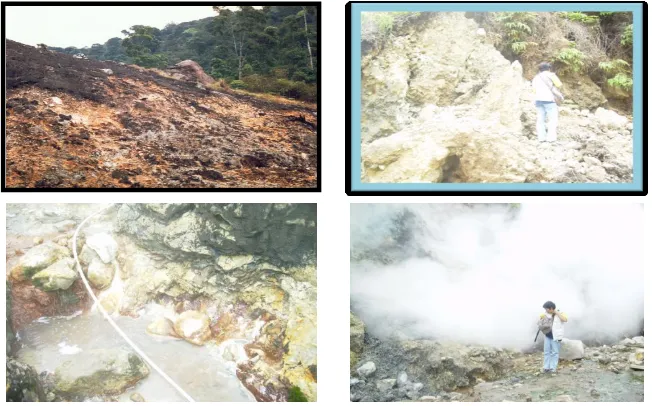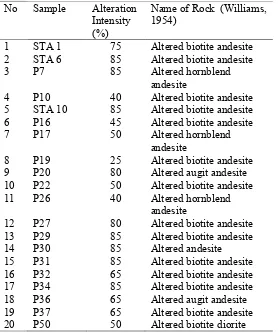Journal of Techno
DAFTAR ISI
Geotechnical Risk Management And Mitigation At Grasberg Open Pit PT. Freeport Indonesian...
Barlian Dwi Nagara, Arjuna Ginting
3
Geothermal Prospect Analysis Based On Geomorphology And Alteration of Ungaran Geothermal Field...
T. Listyani R.A., Ev. Budiadi
15
Alteration and Gold Mineralization Paningkaban Areas Gumelar Sub-District, Banyumas Regency, Central Java Province...
HS Purwanto, H. Riswandi
20
Slope Stability Analysis of The Pathuk Hill for The Resorts Development
Jatmika Setiawan, Bagus Ngurah Kresna C., Arya Dwi Sanjaya., Adrianus Bayu
37
Kondisi Cekungan Airtanah Wates Pra Konstruksi Bandara Internasional Temon Kulonprogo, Daerah Istimewa Yogyakarta...
Purwanto, Arif Rianto Budi Nugroho, Intan Paramita Haty
50
Regeneration Callus of Chrysant After Irradiated Ray Gamma for The Resilience of Plain Medium...
Ari Wijayani, Muafi, Endah Wahyurini, Rina Sri Lestari
61
Studi Potensi Tanaman Buah di Lahan Pekarangan Berbasis Pewilayahan Komoditas di Kabupaten Bantul, Daerah Istimewa Yogyakarta...
Angki Intan Utami, Wafit Dinarto
68
Pengembangan Sistem Office Automation (SOA) Menggunakan E-Mailing System Online...
Mangaras Yanu Florestiyanto, Hidayatulah Himawan, Wilis Kaswidjanti, Bambang Yuwono
82
Ekstraksi Flavonoid Dari Tanaman Obat Sebagai Anti Oksidan...
Gogot Haryono
90
ISSN : 977-2461-14800
GEOTHERMAL PROSPECT ANALYSIS BASED ON GEOMORPHOLOGY AND ALTERATION OF UNGARAN GEOTHERMAL FIELD
T. Listyani R.A. and Ev. Budiadi
Geological Department, STTNAS Yogyakarta Email : [email protected]
Abstract
Ungaran is one of geothermal fields in Java Island. Geomorphologically, the prospective areas is located in Mt.Ungaran, Central Java. This volcano is active but it is already in post volcanism stages, indicated by eroded, gently slope topography in its summit or slopes. This geomorphological characteristics indicate moderate stage of geothermal prospect. This area consist of variable volcanic rocks, show the hydrothermal alteration. The alteration type usually occur in argilitization - chloritization types with have more altered in the depth. This modium alteration stage indicate
moderate to high geothermal prospect, supported by less intensive manifestation of outcrop’s
alteration.
Introduction
This paper wrote as descriptive analysis of Gedongsongo geothermal prospect areas in Central Java. The geomorphology and rock characteristics in this geothermal fields has been described to know about the geothermal condition of geothermal stage and prospect. The analysis of general characteristics of geothermal has been carried out based on secondary data, supported by author’s experiences in some geothermal projects in this area.
The geothermal is well known as alternative energy resource in Indonesia right now. This resource may be main resource in the future, as the most increasing of demand of energy supply. Geothermal itself, affords to alternate others non renewable energy sources because of its characteristics such as renewable, sustainable and friendly to our environment.
One of the most popular region of geothermal in Indonesia is Java Island. This island has many geothermal spots, all of them are in volcanic areas. There are active
volcanoes in Central Java which have potential of geothermal resources, one of them is Ungaran volcano. This volcano yield Gedongsongo prospect area. This article tells about the geothermal characteristics especially on geomorphology and alteration of rocks. The descriptive article should be important to make better understanding of prospect geothermal resource.
Geomorphology
Stream erosion usually refer to area stage. According to Van Zuidam (1983), stream erosion produces many types of valleys, most of which exhibit topographic features revealing lithology, geologic structure, conditions of erosion and the
geomorphologic history or the area during erosion. The valley form types can be distinguished as broad, gently sloping and shallow valleys in foot slope of Mt. Ungaran, indicate maturity stage of morphology.
a. b.
Figure 1. Morphology of Ungaran volcano.
Source: a. Energy & Mining Dept. of Central Java – Geomap, 2005.
b. The author, 2013.
Whereas, V-shaped valley, which can be either wide or more narrow shaped usually can be found at summit to the upper part of Ungaran body, indicate young stage of morphology. Young to maturity stage of geomorphology indicate the moderate prospect of geothermal.
Like other prospect areas, Gedongsongo geothermal system also supported by rim structure. This collapse structure should be easier known from remote sensing. Eruption center of its mountain is lied in collapse structure (Figure 2). This structure looks like cross faults made round shape, formed rift fault system which opened northeastward (to Mt. Ungaran peak direction). The activities of Mt. Ungaran were controlled by this collapse structure. The other structures appearance are northwest – southeast and southwest – northeast faults. The north – south direction fault passed Gedongsongo area is predicted to control geothermal manifestation in this region.
Litology
The Ungaran geothermal system consists of Pleistocene rocks in the upperpart of geothermal area. Stratigraphy of volcanic products may be take role as reservoir and cap roks of geothermal. The heat source of Gedongsongo prospect is magma chamber of active Ungaran Mountain. This heat had produced alteration rocks in the basin.
in Java. Reservoir rock of Gedongsongo area supported by old pre caldera volcanic and sedimentary rocks of Kerek and Kalibeng Formation. Young Quaternary volcanic rocks, especially lava, usually act
as cap rocks. Young volcanic rocks of post caldera activity of Mt. Ungaran well functioned as cap rock of Gedongsongo geothermal system.
Figure 2. Manifestation map of Ungaran geothermal area (Pertamina, 1994). The collapse structure indicated by cross curves around the peak.
Alteration
As the manifestation appearance there are some alteration rocks of outcrop in Gedongsongo and surrounding area. The
alteration seems not intensively, only showed at several locations (Figure 3). The alterations rocks are usually outcropped around fumarole location.
Figure 3. The alteration volcanic rocks at Gedongsongo area, show yellowish brown or black in color with sulfuric coating (upper). Alteration rocks around hot spring and fumarole (lower).
Around fumarole, there are some small hot springs with yellow sulfuric deposit. The
in color. Their alteration type usually include in argilitization type. These alteration fenomena occur in andesitic lava and breccia (Disbang Jateng – STTNAS, 2004). They can be obviously observed from the color and petrophysic. The petrophysic characteristic usually show soft, uncompacted, weathered condition of outcrops. Sometimes, the odor of sulfur strong smelled at the place surrounding the alteration rocks.
The alteration process not only showed on the surface. There are some alteration occur in the depth, even more intensively. Geoservices (1992) wrote that there are rocks which alteration intensity and level increase to the depth. The strongest intensity and alteration level occur in depth of 447 – 500 m which 50 – 75 % alteration intensity indentified by chlorite increasement until 25% and secondary quartz reach 12%. This data show that in this interval depth there is higher temperature compared with upper depth. The alteration types found as argilitization and chloritization types.
Further, Geoservices (1992) also remark that there are socandary and primary biotite minerals can be noticed from petrographic analysis. This fact can be interpreted that geothermal process in this area occur higher temperature of thermal periode in the past. The temperature measured now is 52oC in depth of 500 m based on temperature gradient measurement.
Energy & Mining Departement of Central Java and C.V. Geomap, 2005 report some alteration rocks from Gedongsongo area. From petrographic analysis, there are some rock samples show variable alteration, usually have weak to strong alteration intensity (Table 1). The rocks
vary in altered diopsid andesite, altered biotite andesite, altered hornblend andesite and altered augit andesite. The altered minerals commonly show chlorite, clay mineral, iron oxyde as well as calcite, occured from replacement process. This alteration process was influenced by geothermal condition.
On the other hand, Listyani & Budiadi (2006) said that alteration rocks at Gedongsongo area consist of volcanic breccia and igneous rock which commonly have argilitization to chloritization types. Alteration minerals came from replacement process and producted secondary minerals such as clay minerals, chlorite, iron oxyde, pyrite, biotite, carbonate minerals and samll abundance of quartz. The alteration intensity vary from low (20%) until high (85%).
Based on Hayashi classification (1973, vide Listyani & Budiadi, 2006), Gedongsongo has alteration type II, sub-type IIb – IId or IVc, with formation temperature higher than 230oC in sulfuric weak to strong acid solutin condition. By considering altered minerals variaty to depth therefore the research area at least has three alteration zones, which each zone is dominated by secondary minerals such as clay minerals, chlorites and ore minerals.
Table 1. Result of petrographic analysis of rocks at Gedongsongo.
No Sample Alteration
Intensity (%)
Name of Rock (Williams, 1954)
1 STA 1 75 Altered biotite andesite
2 STA 6 85 Altered biotite andesite
3 P7 85 Altered hornblend
andesite
4 P10 40 Altered biotite andesite
5 STA 10 85 Altered biotite andesite
6 P16 45 Altered biotite andesite
7 P17 50 Altered hornblend
andesite
8 P19 25 Altered biotite andesite
9 P20 80 Altered augit andesite
10 P22 50 Altered biotite andesite
11 P26 40 Altered hornblend
andesite
12 P27 80 Altered biotite andesite
13 P29 85 Altered biotite andesite
14 P30 85 Altered andesite
15 P31 85 Altered biotite andesite
16 P32 65 Altered biotite andesite
17 P34 85 Altered biotite andesite
18 P36 65 Altered augit andesite
19 P37 65 Altered biotite andesite
20 P50 50 Altered biotite diorite
Based on the data described above its can be known that alteration process occur from the depth until surface. The intensity and level usually catagorized as moderate condition. This condition support geothermal potential which not high prospect. This condition require more supporting data to know geothermal prospect more accurate.
Conclusion
There are some descriptive characteristics of geomorphology and petrology of rocks in Ungaran geothermal prospect area. The characteristics can be explained as below.
1. Geomorphology of Gedongsongo geothermal area shows the old Quaternary volcano which
considered as potential geothermal. The volcano has been in the post volcanism indicated by eroded morphology on the slope of volcano. This characteristic usually refer to moderate potential of geothermal energy. Young to maturity stage of geomorphology of Mt. Ungaran also indicate the moderate prospect of geothermal.
rocks both on the surface or in the depth.
3. The manifestation of geothermal is shown by alteration rocks both on the surface as outcrops and rocks in the depth, with weak to high alteration intensity, strong supported by attendance of secondary minerals. The alteration fenomena strong the moderate to high potential of Ungaran geothermal prospect.
Acknowledgment
This paper supported by Dikti & Kopertis V Yogyakarta through fondation of Fundamental Research 2012-2013, so the authors should gratefully appreciate to the institution. This paper was written based on many experiences that have got mainly from projects. Therefore, the author would like to appreciate to all persons who have given the opportunity for participating in geothermal projects, which cannot be enumerated.
References
Sudradjat, A., 2009, The development of volcanological investigations in indonesia, Faculty of Geology, Padjadjaran University, Bandung, Indonesia.
Energy & Mining Department of Central Java – Geomap, 2005, Survai landaian suhu di kompleks panas bumi Gedongsongo, Kabupaten
Semarang, Final report,
Unpublished.
Energy & Mining Department of Central
Java – STTNAS, 2004,
Pengembangan Pemanfaatan
Energi Panas bumi (Survei
Geokimia) di Kompleks Panas bumi
Gedongsongo, Kabupaten
Semarang, Laporan Akhir, tidak dipublikasikan.
Listyani, T., 2011, General Geological Characteristics of Geothermal Fields in Volcanic Areas of Java
Island, dalam Pemanfaatan Teknologi dan Informasi untuk Mitigasi Bencana Alam, Prosiding Seminar Nasional ke-6 Tahun 2011 Rekayasa Teknologi Industri dan Informasi (ReTII), STTNAS Yogyakarta, ISSN 1907-5995, Desember 2011.
Listyani, T., dan Budiadi, Ev., 2006, Tinjauan Alterasi Batuan di Daerah Prospek Panasbumi Gedongsongo, Jawa Tengah, Jurnal Wahana Teknik, Vol. 8, No. 3, Kopertis Wil. V, Yogyakarta, Desember 2006. Pertamina, 1994, Buku Potensi Cadangan
Panas bumi, Pertamina EP, Jakarta. Van Zuidam, R.A., 1983, Guide to
geomorphologic aerial


